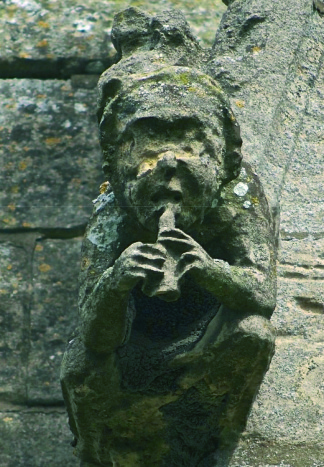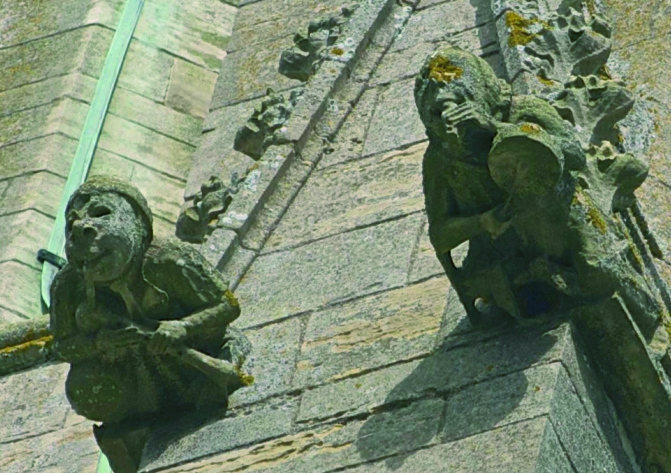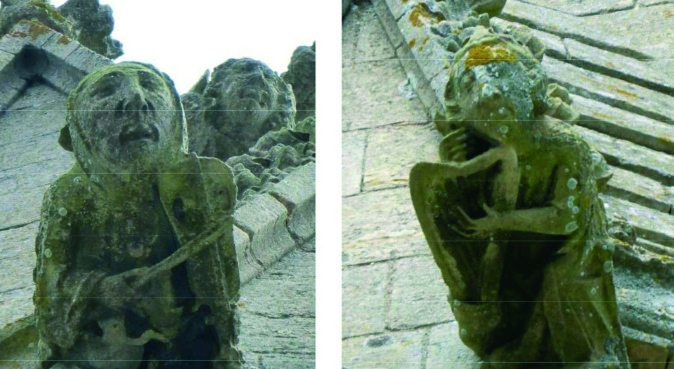The Bagpipe Society
The Grotesques of Heckington
St Andrew’s Church, Heckington is a Grade 1 listed Anglican parish church in Lincolnshire. It is of cruciform plan and in a complete ‘decorated’ style representative of English gothic architecture. Dating from the early 14th century, the church was acquired by Bardney Abbey in 1345. The church’s greatest glories are due to the generosity of two men linked with King Edward II, Lord Henry de Beaumont and Richard de Potesgrave (c.1275-1349).

Beaumont’s coat of arms once appeared in many of the stained-glass windows, and Richard de Potesgrave was in 1309 both rector of Heckington and the King’s chaplain. Among these medieval glories are a series of finials carved in the form of grotesques from limestone ashlar. These adorn the outer sections of the spire, and many have been crafted playing musical instruments. That these figures have lasted for nearly seven hundred years without extensive weathering is a remarkable testament to the dedication of the original stonemasons. As decorative features they are certainly striking. More importantly, from our point of view, they present a historical document, illustrating a number of historical musical instruments and the manner in which they might have been played. The musicians can be seen playing pipe-and-tabor, bagpipes, whistle, harp, medieval fiddle and a number of less-identifiable items. It is evident that the characters portrayed are not meant to be representative of sacred subjects, rather they were the idiosyncratic features of the common man.

You might wonder how a church of this scale and grandeur happened to be built in Heckington, a farming community on the edge of the Lincolnshire fens. The short answer is ‘royal patronage’. The longer answer is a little more complicated: in 1305 (or thereabouts) work began on constructing a new church, funded by the Lady of the Manor, Lady Flora de Gant. In 1309, Lady Flora died leaving no heir, so her estate reverted to the crown. Also in 1309, the incumbent rector of the church died. The new rector would normally have been appointed by the Abbot of Bardney Abbey, but at that time Bardney was without an Abbot, so the appointment of the rector of fell to the King.
King Edward II then gave the de Gant estates in the Heckington area to his bellicose supporter Henry de Beaumont and appointed one of his own chaplains, Richard de Potesgrave as the new rector. The village was therefore placed in the hands of two very rich and powerful men. Between them, along with their cultured and influential womenfolk, they funded and oversaw the construction of a magnificent, decorated gothic church in Heckington. The crowning glory of this ‘state of the art’ place of worship was the tall, highly decorated chancel, thought to be the vision of Richard de Potesgrave himself, which would have rung with the sacred singing of men and boys, several times each day. There may even have been an organ to augment the singing and give the singers intervals of instrumental music in which to rest their voices. The singing would have been of professional standard and may well have been influenced by the music of the Chapel Royal, with which Richard de Potesgrave and Henry de Beaumont would probably have been familiar. So much for the ‘highbrow’ music of the chancel … Edward II was instrumental in the development of this church through the patronage of his supporters, Potesgrave and Beaumont: there are stone heads in the church considered to be portraits of the king. Edward II is also thought to have enjoyed secular musical entertainment and is known to have paid individual minstrels, possibly at a location quite close to Heckington. Edward II met a bad end (probably) in 1327. In 1330, his son, Edward III visited Heckington for several days, just before he took the reins of power from his mother, Queen Isabella, and Mortimer. Richard de Potesgrave continued as chaplain to the new king and, around this time, Henry de Beaumont returned from exile to support Edward III. After a life of battling and intrigue, Henry de Beaumont died in 1340. In 1345, Heckington church reverted to Bardney Abbey but Richard de Potesgrave remained as Rector until he died in 1349, aged about 75, possibly from the Black Death. Their beautiful church remains at the heart of the community of Heckington.
This article first appeared in The Galpin Society Newsletter, October 2015 and I am very grateful to them for Andy Lamb for giving permission for it to be reproduced.. *

Photos: Pete Banks and Mary Cummins
- Data Processing Notice (GDPR)
@BagpipeSociety on X (formally known as Twitter)
TheBagpipeSociety on Instagram
 BagpipeSociety on Facebook
BagpipeSociety on Facebook
Something wrong or missing from this page? Let us know!
